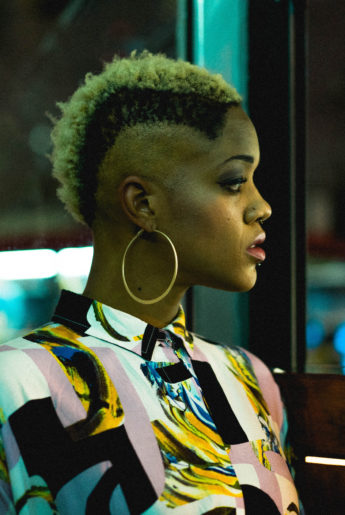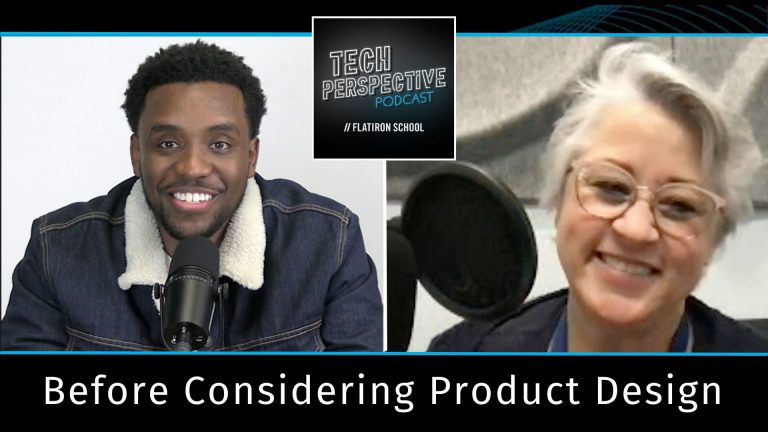UX/UI Product Design Curriculum
Our curriculum now includes emerging technologies, including the latest artificial intelligence (AI) tools.
Download The Syllabus
All students are required to complete pre-work before the start of Phase 1 to have a working knowledge of UX and UI processes. During Prep, students prepare for success by familiarizing themselves with the the tools and processes they will utilize during the Product Design course including Figma and Webflow.
In Phase 1, students will learn about using generative AI as a research analysis tool. Discover how to develop personas and user journeys, conduct market research on competitors, use natural language processing (NLP) to automate the identification and categorization of patterns, and draft surveys for gathering user data. By the end of this phase, students will be able to identify potential opportunities and threats in a product design environment as well as evaluate the long-term effects of AI on design.
In Phase 2, students will learn the essential components of the UI (User Interface) design process, including standard tools, best practices, and deliverables. Learn the fundamentals of interface design as well as how to co-create with AI for inspiration. Explore more about prompt engineering, which can generate design elements such as typography, color palettes, and design patterns based on project requirements. By the end of this phase, students will have hands-on experience and be equipped to harness the full power of AI to fuel the creative process.
In Phase 3, students will learn how to use generative AI to develop content for design projects. Explore how AI can be used to create ideas for content outlines, headings, descriptive copy, microcopy, error messages, FAQ’s, keyword research and SEO. By the end of this phase, students will be able to use AI as a powerful tool to create compelling and effective designs, enabling better communication with users as well as improved user experiences.
In Phase 4, students will learn how to use generative AI to prompt for whiteboard challenges, which will help develop design thinking skills. You will receive evaluations of completed design challenges, which will help you to refine your approach and develop your design skills further. Also, you will have a chance to how to use generative AI to craft compelling narratives to convey the purpose of your work to clients or stakeholders. By the end of this phase, students should develop the ability to think creatively and communicate design ideas effectively.
In Phase 5, students will create and launch an online portfolio of their best work. They will author a case study that explains the insights and decisions they made during the product design process. This program will challenge students to talk competently about their work and to communicate their strengths in UX and UI as they prepare to enter the job market.
Possible Career Paths
Product Designer
Average Salary: $91,691*Product Designers are a jack of all trades with a deep understanding of UI and UX. They research business competition and are keen on business goals.
*ZipRecruiter (May 2023)
UX Designer
Average Salary: $103,429*UX Designers focus on the experience of a digital product. They leverage research to understand roadblocks that customers may face.
*ZipRecruiter (May 2023)
UI Designer
Average Salary: $90,553*UI Designers focus on the visual experience of a digital product. This may include fonts, colors, style guides, animations, and responsive design.
*ZipRecruiter (May 2023)
Web Designer
Average Salary: $71,855*Website Designers typically focus on designing in a way that encourages website visitors to take specific actions in order to meet the goals of their website.
*ZipRecruiter (May 2023)
Learn At Your Own Pace
Our students understand that there’s a lot of hard work ahead of them, but we also understand the need for flexibility. We deliver a structured learning experience that adjusts to your lifestyle. Your admissions representative will help you choose the option that makes sense for you.
Full-Time
You’re ready to commit to a full-time course load. You’ll graduate in 15 weeks thanks to a rigorous schedule: 8 hours a day, Monday to Friday.
- 15 weeks long
- In-person or online
- Synchronous learning with your cohort
- Course highlights:
- Group work with instructor help
- Paired with design sessions
- Lab time with instructional staff
Part-Time
Our part-time course is designed for busy people. If you don’t have 8 free hours to dedicate a day (same), then our part-time course is for you.
- Paced to complete at 40 weeks
- Online only
- Asynchronous learning at your own pace
- Course highlights:
- Pre-recorded lessons
- Optional live lectures and office hours
- Slack with classmates and instructors
What is Product Design?
Meet Our Curriculum Experts
Our curriculum was built by actual UX / UI Product Designers with real-world work experience.
Siana Altiise

Former Product Designer for Dell Labs. Has designed learning experiences for Meta and ELM Learning. Performs as a sensory artist and is a certified Rescue Diver.
Delminquoe Cunningham

15 years of experience in the arts, 3D design, animation, and UX / UI design. Former professor at Art Institute of Atlanta before taking over its media course in 2013.
Anwar Montasir

20 years of experience as a designer, developer, educator, and curriculum writer. Anwar has taught a wide variety of courses in colleges and bootcamps.

Tuition
We have 3 easy ways to pay:
- Pay upfront
- Pay in 12 monthly installments with 0% interest
- Pay with a loan
Frequently Asked Questions
The Live program is 15 weeks, but rather than going to a campus, you’ll be logged on learning remotely full-time. Both on-campus and Live programs monitor attendance daily. The Flex program gives students up to 60 weeks to complete the curriculum, and offers the most flexibility day to day. Students enrolled in Flex programs must attend 10 check-ins in order to be eligible for graduation but are not otherwise required to attend live instructional activities.
Product Design is a holistic concept that has ownership over both UX (user experience) and UI (user interface) design. UX design focuses on the total user experience with a digital product. UI design focuses on the visual experience of a digital product, such as fonts, colors, and animations.
Yes! Product Design is a career with many opportunities and that is relatively future-proof given how many different disciplines it covers – research, analysis, design, experimentation, and more. Flatiron School’s Product Design course prepares students for a variety of career paths, including UX Designer, UX Researcher, UX Writer, Interaction Designer, UI Designer, UI Engineer, Visual Designer, Communication Designer, Information Architect, or Full Stack Designer, just to name a few.
Good UX / UI helps companies achieve their goals. It can help effectively communicate a company’s value, win customer confidence, or even close a sale.
No! While there is a decent amount of drawing involved in UX / UI Product Design, the purpose is to develop or communicate ideas. That can be done very simply – meaning, it doesn’t take a great deal of artistic talent. See this explained firsthand in a Sketching for Design instructional session.
Before beginning day one at Flatiron School, students will gain access to a pre-work curriculum that covers the course structure, an overview of design tools such as Figma, Invision, and Webflow, and the basics of UX and UI design.
Throughout the course, students will receive hands-on guidance from experienced instructors. We will teach ethical and inclusive design, HTML and CSS, and more. We often bring in guest speakers – past guests have included designers from Oracle, Finstra, and Dataquest (just to name a few). Students will have ample opportunity to participate within Flatiron School’s community events and meet people from other cohorts.
Upon graduation, you’ll receive up to 180 days of one-on-one career coaching, dedicated to helping you find a job in the digital design industry. This includes resume reviews, job search advice and support from experienced coaches, and mock interviews.
Graduates receive up to 180 days of career services, which includes one-on-one career coaching sessions.
Our career services include resume reviews, job search advice and support from experienced coaches, and mock interviews to ensure that our students feel supported along the way.
The first step is to fill out a written application. Once submitted, you will receive prompts from the admissions team to schedule an interview and take a 15 min aptitude assessment. During the interview a member of the admissions team will learn about your learning needs, career goals, and help you decide whether the program is the right fit for you. If you passed your assessment, we will give you the admissions decision after your interview.
The Flatiron School Career Services team exists to help get you hired. You’ll receive guidance on how to:
- Build and Optimize your LinkedIn Profile and Resume
- Ace your behavioral and technical interviews
- Grow your network of tech professionals
- Connect with Flatiron School employer partners
- Negotiate your salary
- Optimize your job search using AI
- Track job search activity using Huntr
You’ll partner with a dedicated Career Coach regularly to make forward progress each week, with up to six months of one-on-one support after graduation.
You have a few options in terms of financing your enrollment in one of Flatiron School’s courses. See all of your options on our Tuition & Financing page.
We also offer initiatives that can help to offset the cost of tuition on our Scholarships and Diversity Initiatives page.
Feel free to schedule a chat with one of our Admissions representatives. They are here to answer your questions and help you decide the best next steps. Recent students have described their Admissions reps as “easy, supportive, friendly, transparent, and personal.”
You can view our latest job placement rates in our Jobs Report.
We’ve issued a third-party examined Jobs Report each year since 2014 and remain committed to honesty and transparency with student outcomes.
